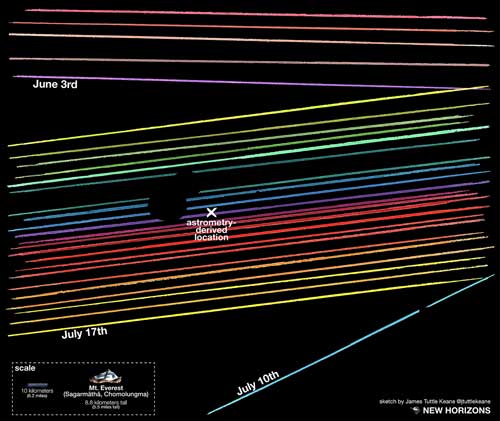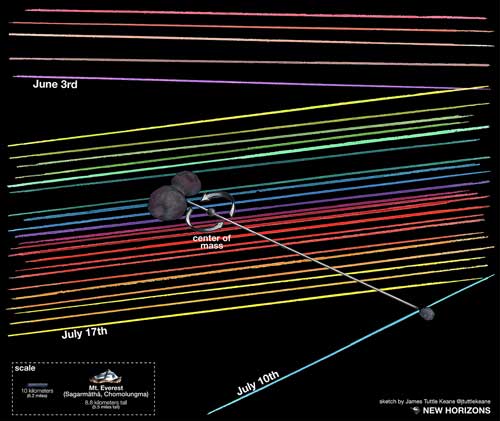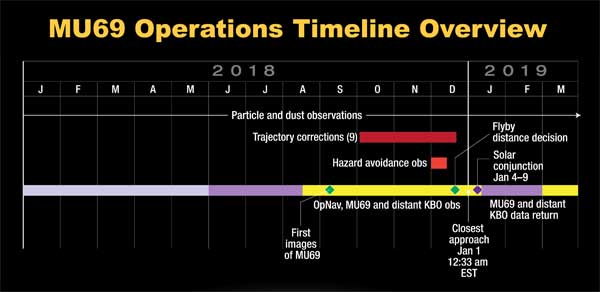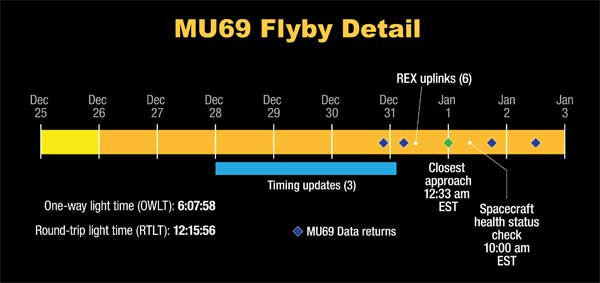| Update (March 27, 2018): A new analysis shows that the suspected moon isn't actually there. Marc Buie (Southwest Research Institute) had used Gaia data to pin down the positions of stars in images of the 2014 MU69 occultation. Turns out that some subtle bugs in the analysis had tweaked the stars' positions just enough to make it look like a background star had briefly been blocked by a moon of 2014 MU69, when instead it was actually 2014 MU69 itself that had done the blocking. Read more details from Emily Lakdawalla at The Planetary Society. |

New analysis from the New Horizons team suggests that the spacecraft’s next target, a Kuiper Belt object known as 2014 MU69, might have a moon. The object was already thought to be a binary, so this brings the party members to three. The preliminary results were presented at the meeting of the American Geophysical Union in New Orleans.
New Horizons will fly 3,500 kilometers from this little rock in the outer solar system on January 1, 2019. Although it’ll catch the first, better-than-Hubble glimpse in early September 2018, the initial views won’t resolve the object — we’ll see it as a steadily brightening pixel via the spacecraft’s long-range camera. It isn’t until after the flyby that we’ll begin to see stunning, high-resolution images depicting its surface. (The immense distance — 6.5 billion kilometers from Earth — means that the data will keep trickling in through 2019 and most of 2020, but the first views will come in about a week after the flyby.)
In preparation for the flyby, the team deployed observers across the globe to monitor occultations on June 3rd, July 10th, and July 17th. On these three dates, 2014 MU69 passed in front of three different stars. Although the object itself was invisible, the stars, and their disappearance, was observable — as long as the observers were in the right location.
The team had no luck on the first occultation. The second event resulted in a small blip, but the team wasn’t sure what it signified — the star’s short blink-out didn’t occur where it was predicted to be. The third event was where the team struck gold: five of 24 observers caught the star blinking off and on again. Subsequent analysis showed that the shape of the object was definitely not spherical. It could be potato-shaped, but Marc Buie (Southwest Research Institute) prefers a binary scenario, where two large objects, 15-20 kilometeres in diameter, orbit each other so closely they might even be touching.

NASA / JHUAPL / SwRI / James Tuttle Keane
But now the plot thickens: that blip that the team recorded on June 10th might not be nothing after all. The team conducted new analysis that includes observations of 2014 MU69’s orbit using data from the sharp-eyed Gaia mission. It turns out that the Kuiper Belt object might have a third member of its party: a much smaller moon.

NASA / JHUAPL / SwRI / James Tuttle Keane
“This is probably a sign that the object itself was not a collisional fragment. We think it was made like this,” Buie said in a press conference. “We really are going to see something that dates back to the birth of the solar system.”
However, Buie cautioned that the three-body explanation isn’t yet a final result.
“The story could change next week . . . we’ve been changing the story a lot since July 17th,” Buie added. “But today, right here, right now, we think this is our best explanation for everything we’ve seen.”
If you’ve ever wondered why we’re sending a spacecraft to study diminutive rocks in the frigid, outer reaches of the solar system, this is why: to explore objects nearly untouched by time. MU69 2014, however many pieces it may consist of, will shed light on the accretionary, planet-forming environment of our system’s early years.
The mission won't end with MU69 and its potential companions: In addition to sending back data, New Horizons will continue observing about 30 other Kuiper Belt objects from a larger distance throughout its extended mission, which goes through 2021. The mission could even be extended again, as its fuel could last until the mid-2030s.
For now, here's what we have to look forward to in the coming months:


 3
3









Comments
opticsguy
December 16, 2017 at 10:21 am
Way way back when I was much younger, I had always wondered if I would ever make it to our new century, the one we live in now. I would have to be able to live to 50 years old, my god that would be so old!! Yet for me, in many ways, life really started at 50...........
Now can I make it another year and 15 days? Whats so special? The flyby of 2014 MU69, the object in line for the New Horizons spacecraft. Of all the spacecraft currently in operation, this one, for me, is the most interesting and exciting!! Flyby is Jan 1, 2019 and will certainly bring in the new year!!
Cant wait but yet again, time is passing by too swiftly, so, yes, I can wait.
And where and what is the next target of this incredible spacecraft after MU69? Cant and wait and so exciting!!!!!
You must be logged in to post a comment.
Anthony Barreiro
December 16, 2017 at 10:55 pm
The article text says the occultations occurred on June 3, *June* 10, and July 17. The two illustrations have tracks for June 3, *July* 10, and July 17. Which is correct?
You must be logged in to post a comment.
Monica YoungPost Author
December 17, 2017 at 9:37 am
July 10th is correct - thanks for the catch, I've changed the text.
You must be logged in to post a comment.
You must be logged in to post a comment.